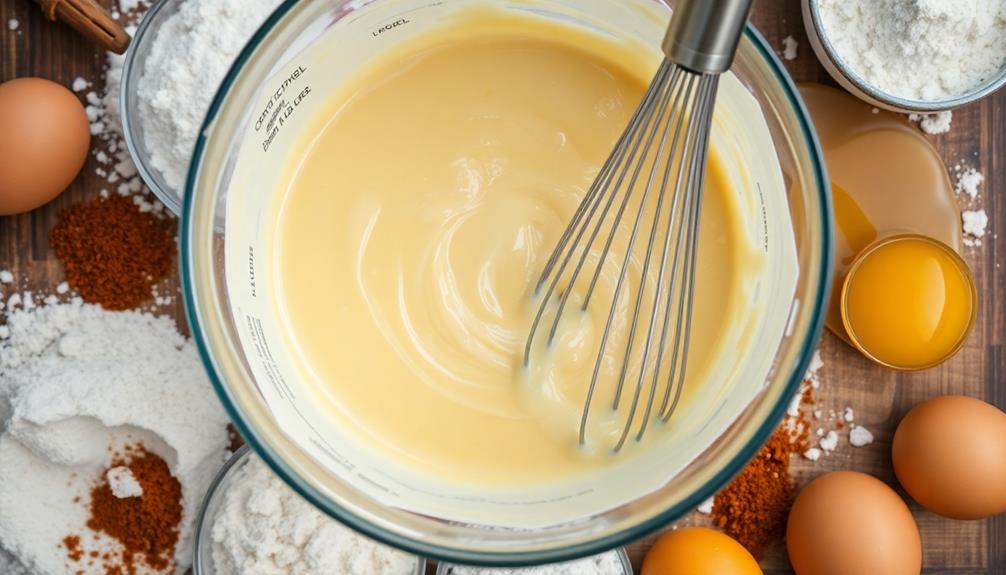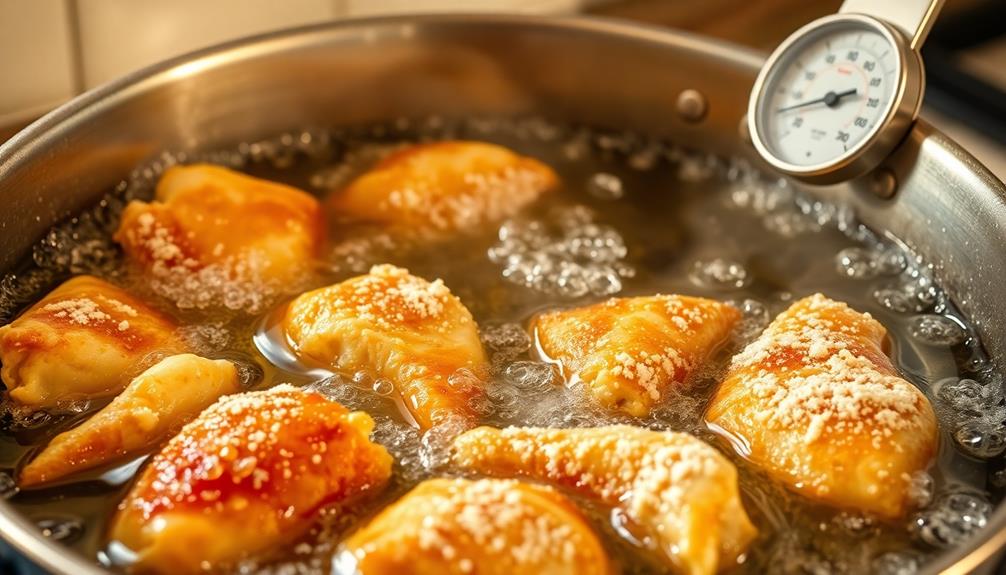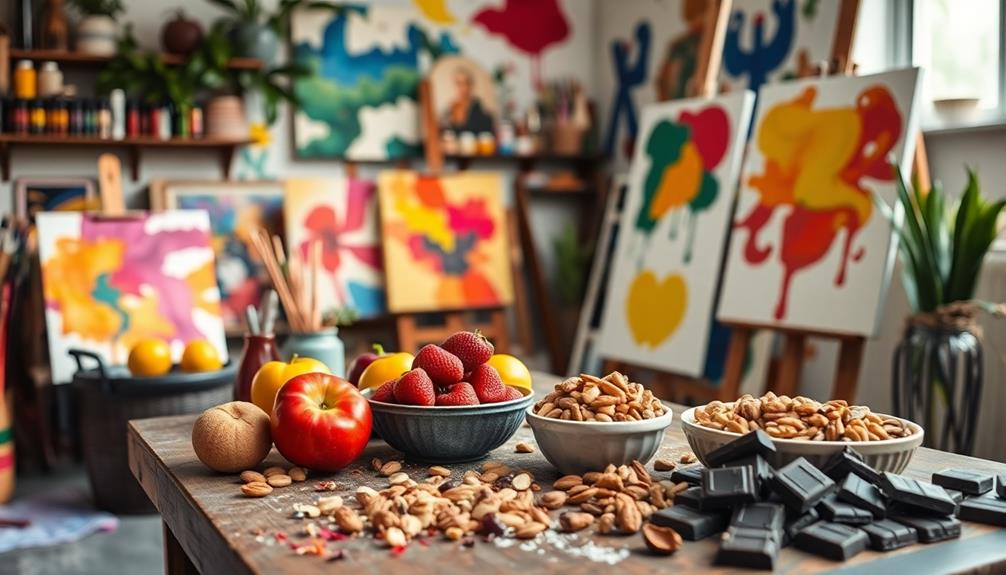To create the perfect crispy food coating, you need a balanced mix of flour, liquid, and leavening agents. Opt for lower gluten flours, like rice flour or cornstarch, which enhance crunchiness. Fresh, high-quality ingredients are a must, especially for flour. Use carbonated liquids to introduce airiness or vodka for a delicate crust. Maintain oil temperature between 160°C and 190°C to avoid soggy results. Monitor the heat to guarantee even cooking, and fry in small batches. Mastering these techniques will transform your coatings. Keep exploring to elevate your frying skills even further.
Key Takeaways
- A balanced flour-to-liquid ratio is crucial to achieving a light, airy batter that doesn't become greasy when frying.
- Choosing the right flour, such as a blend of all-purpose and rice flour, enhances crispiness while reducing gluten formation.
- Using carbonated liquids or ice-cold water introduces bubbles, resulting in a lighter and crispier coating during frying.
- Maintaining the ideal oil temperature (160°C to 190°C) ensures a golden, crispy finish without sogginess or burning.
- Freshness of ingredients, particularly flour and leavening agents, significantly impacts the flavor and performance of the batter.
Understanding Batter Basics

Understanding Batter Basics
When you whip up a batter, it's vital to get the basics right to achieve that perfect crispy coating. The foundation of a good batter is a balanced mix of flour, liquid, and leavening agents. This balance not only affects flavor but also influences texture. A proper flour-to-liquid ratio enhances lightness and airiness, allowing the batter to cling effectively to your food, resulting in that desirable crispy exterior. For instance, when preparing dishes like Pasta Alla Norma, achieving the right coating on eggplant is essential for enhancing the overall dish.
Consider using different types of flour, like rice flour or cornstarch, which contain lower gluten content than wheat flour. This helps improve crunchiness, as less gluten formation means a lighter coating. Incorporating leavening agents is essential as they introduce air into the batter, contributing to its overall lightness and crispy texture when fried.
Don't forget about the freshness of your ingredients, particularly the flour and leavening agents. Fresh ingredients greatly impact the performance of your batter.
A good frying technique also plays a pivotal role—ensure your oil is at the right temperature to achieve that golden, crispy finish. By mastering these batter basics, you're well on your way to creating deliciously crispy dishes.
Choosing the Right Ingredients

Choosing the right ingredients is essential for achieving that perfect crispy coating. The choice of flour greatly impacts the texture of your batter. For ideal crispiness, consider blending all-purpose flour with lower gluten options like cornstarch or rice flour. Freshness matters too; stale flour or expired starches can ruin both flavor and performance.
Different starches each bring unique textures to your crispy fried dishes. For instance, potato starch is known for its superior crunch and moisture retention. Don't forget about leavening agents like baking powder, which can elevate the crispiness and browning, enhancing the overall visual appeal.
Experimenting with liquids can also yield fantastic results. Using beer or carbonated water introduces extra flavor while creating a lighter, airier batter thanks to carbonation.
Here's a quick reference table for choosing the right ingredients:
| Ingredient | Benefits | Suggested Use |
|---|---|---|
| All-Purpose Flour | Versatile, good texture | Base for coating |
| Cornstarch | Light, crispy finish | Mix with flour |
| Rice Flour | Gluten-free, extra crunch | Blend for texture |
| Potato Starch | Moisture retention, crunch | Best for frying |
| Baking Powder | Enhances crispiness/browning | Add to batter |
The Role of Flour

Flour plays a pivotal role in achieving that perfect crispy coating. The type of flour you choose can greatly influence how well the batter adheres and its final texture. High-gluten flours may give you a tougher, chewier crust, which isn't ideal if you're aiming for something light and crunchy. Instead, consider using lower gluten options like rice flour or cornstarch to achieve that desirable crunchiness. For example, using rice flour can enhance the texture of snacks like Paoca, which benefits from a crunchy coating.
Blending different flours can also enhance the crispiness of your coating. For instance, mixing all-purpose flour with rice flour or cornstarch can result in a more durable and crispy finish.
Remember, the flour-to-liquid ratio is essential; getting this balance right helps maintain the lightness of your batter while preventing greasy coatings.
Lastly, the freshness and quality of the flour you use will impact both the flavor and crispiness of your fried foods. Selecting the right flour isn't just a detail—it's key to creating that ideal crispy coating that elevates your frying game.
Liquids and Their Effects

The liquids you incorporate into your batter can make or break its texture and crispiness. For a lighter, crispier result, consider using beer or club soda. These options introduce carbonation, creating bubbles that enhance the overall texture of your coating.
Alternatively, if you want a more delicate crust, vodka is an excellent choice. It reduces gluten formation due to its quick evaporation during frying, yielding a wonderfully crispy exterior. Additionally, experimenting with flavors can lead to exciting pairings; for instance, a light batter could complement the rich taste of Red-Braised Pork Belly.
Don't forget the importance of temperature; using ice-cold water is vital. It helps maintain a low temperature, limiting gluten development and contributing to that sought-after lightness in your batter.
Experimenting with various liquids can also transform the flavor profile of your batter. For instance, buttermilk or flavored broths can add depth and richness to your dish while enhancing that crispy finish.
Importance of Oil Temperature

Achieving that perfect crispy coating doesn't just rely on the liquids you use; oil temperature plays a vital role too. Maintaining the temperature of the oil between 160°C to 190°C (320°F to 375°F) guarantees your food is cooked thoroughly while achieving that crispy exterior. If the oil's too cold, your batter becomes soggy as it absorbs excess oil. Conversely, oil that's too hot can burn the exterior before the inside cooks, ruining the balance.
To help you understand the importance of oil temperature, here's a quick reference table:
| Oil Temperature Range | Result |
|---|---|
| Below 160°C (320°F) | Soggy coating, excess oil |
| 160°C – 190°C (320°F – 375°F) | Crispy texture, cooked thoroughly |
| Above 190°C (375°F) | Burnt exterior, raw inside |
| Consistent monitoring | Essential for perfect frying |
| Fry in small batches | Maintains oil temperature |
Using a kitchen thermometer allows you to track the oil temperature accurately. Always fry in small batches to keep the heat steady, guaranteeing the Maillard reaction creates that coveted crispy texture. Draining excess oil afterward is key to retaining that perfect balance.
Frequently Asked Questions
What Is the Science Behind Crispy Batter?
Crispy batter relies on the right flour and liquid balance, incorporating starches for crunch. You'll need to maintain proper oil temperature to avoid sogginess and eat your food immediately for maximum crispiness.
What Is the Science Behind Crispy Food?
Crispy food's like a perfectly tuned instrument: it requires the right moisture balance, frying temperature, and a sturdy coating. When you nail these factors, you'll enjoy that delightful crunch and irresistible flavor with every bite.
What Makes Coating Crispy?
To make your coating crispy, balance starches and flour, maintain a cold batter, and guarantee hot oil. This helps create a light texture, promotes moisture escape, and prevents greasiness, delivering that perfect crunch you crave.
What Is the Secret to Crispy Fried Food?
The secret to crispy fried food lies in using a mix of flours, maintaining the right oil temperature, incorporating cold liquids, and avoiding overcrowding. These steps guarantee a light, crunchy texture every time you fry.
Conclusion
Now that you've mastered the art of creating the perfect crispy coating, imagine the satisfying crunch that greets you with each bite. Picture golden-brown morsels, glistening with flavor and surrounded by a tantalizing aroma. You've got the knowledge of batter basics, the right ingredients, and the secret to perfect oil temperature at your fingertips. So, go ahead and let your culinary creativity shine; the next crispy masterpiece is just a fry away!









